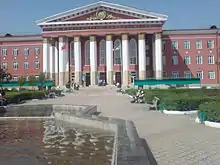Education in Kyrgyzstan
Education in Kyrgyzstan is compulsory for nine years, between ages seven and 15.[1] Following four years of primary and five years of lower secondary school, the system offers two years of upper secondary school, specialized secondary school, or vocational/technical school.[1]
The Ministry of Education and Science (MES) is in charge of education in Kyrgyzstan.[2] Budget cuts that have reduced teacher salaries and equipment availability are reflected disproportionately in reduced numbers of female students.[1]
In 2008, 3.7 percent of gross domestic product was spent on education.[3] In 2001 some 89 percent of the relevant age-group was enrolled in the compulsory program, but this figure has decreased in the early 2000s.[1][3] In 2004 the literacy rate in Kyrgyzstan was 98.7 percent.[1]
Structure and organization
Pre-school and primary education

Pre-school is addressed to children from 3 to 6/7 and is not compulsory.[2] Access to it is limited (net enrollment ratio of 10% in 2005).[3]
Primary school usually starts at 6 or 7, lasts four years and is compulsory. Since 2007, uniforms are required in primary education. The law was pointed out as a source of school-drop out, as the uniform has to be bought by the parents.[3] Teaching quality is sometime described as "poor":[3] Kyrgyzstan ranked last in reading, mathematics and science at PISA 2006.[3]
Secondary education
Secondary education begins with the basic secondary education, which lasts four years and is compulsory.[2] Students have then the choice between comprehensive and vocation educations.
Comprehensive education is constituted of a two-year curriculum, which grants — if completed — a certificate of completion ("attestat"). The certificate is generally required to join a university.[4]
Vocational education is offered through three kinds of courses: A three-year course mixing vocational and general education and preparing for higher education, a two-year course mixing vocational and general education (without preparation to higher education), and a ten-month course of pure vocational education (also open to adults).[5] Vocational education is given in professional lyceum and vocational technical colleges.[5]
Tertiary education

Higher education includes universities, academies, specialized higher education institutes and institutes.[2] There are 54 tertiary education institutions: 33 public for 21 private.[4] The gross enrolment rate in higher education was 12.5% in 2011/2012.[4]
Universities deliver bachelor (Bakalavr) degree in four years, which allows students to pursue master (Magistr) programs, lasting two years. They also offer a "specialist degree" (specialist) in five (or six for medical and architecture studies) years. The specialist and the master degrees open the door to PhD programs (aspirantura).[4]
Academies offer the same degrees in fields of scientific activity. An institute is usually a specialized branch of a university or an academy. Specialized higher education institutes are narrow profiles institutions.[4]
There were criticisms about the competency of university lecturers in Kyrgyzstan: if a Master degree is theoretically required to teach at university, most teachers actually hold a Bachelor or even no degree at all.[4]
See also
References
| Wikimedia Commons has media related to Education in Kyrgyzstan. |
- Kyrgyzstan country profile. Library of Congress Federal Research Division (January 2007). This article incorporates text from this source, which is in the public domain.
- "World Data on Education: Kyrgyzstan" (PDF). UNESCO-IBE. August 2011. Retrieved 16 June 2014.
- "Education in Kyrgyzstan" (PDF). UNICEF. 2008. Retrieved 16 June 2014.
- "Higher Education in Kyrgyzstan" (PDF). European Commission. 2012. Archived from the original (PDF) on 1 December 2014. Retrieved 16 June 2014.
- "Vocational Education in Kyrgyzstan". UNESCO-UNEVOC. 2013. Retrieved 16 June 2014.
External links
- World Data on Education: Kyrgyzstan, UNESCO-IBE(2011) Overview of the Kyrgyz Education system
- Vocational Education in Kyrgyzstan, UNESCO-UNEVOC(2013)- Overview of the kyrgyz Vocational Education system.